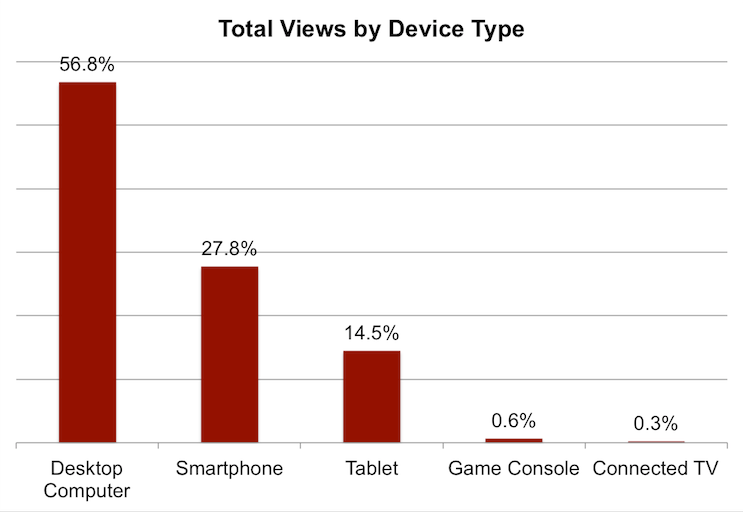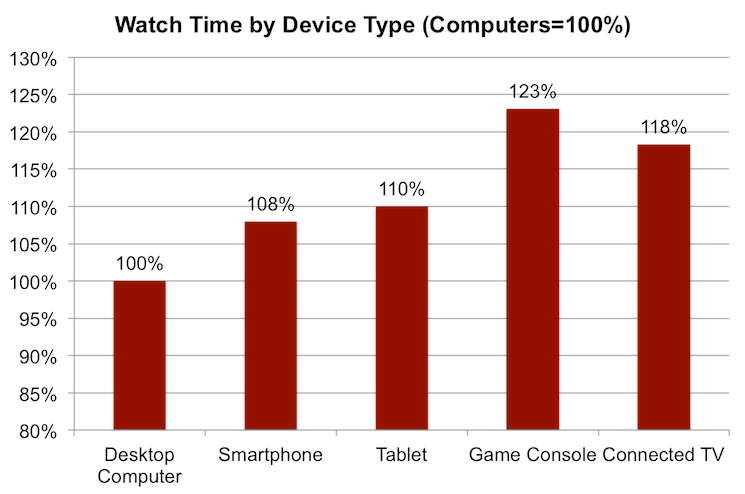We all know that mobile devices have changed the way we consume content online. With over half the US population owning smartphones, and almost as many using tablets, mobile is rapidly overtaking laptops and desktops. The team at Pixability, an online data and tech company, was interested in seeing how this trend affects YouTube viewer behavior, and put together some interesting numbers.
According to their findings (which do not include methodology or sample size, so the reliability may be questionable), individuals are spending more time watching video on smartphones, tablets, streaming TV set boxes, and game consoles than on desktop computers. However, they report that the majority of YouTube views still come from desktop devices.
YouTube’s own statistics show that 40% of total watch time is coming from mobile devices, but when broken down by topic or geography, the number shifts, many times to above 50%.
Viewer Behavior By Device
According to the study, 56% of views originate from desktops, with 28% coming from smartphone and 15% from tablets. Game consoles and streaming television devices currently bring the least amount of viewers. Again, while we don’t know what the methodology or sample size is for this study, this data seems reasonable. Viewer behavior is likely based, at least somewhat, upon convenience. Anyone who utilizes a streaming TV or set top device is likely consuming movies from platforms like Netflix, iTunes, and Amazon. If you’ve ever dealt with YouTube on an Apple TV, it can take longer to locate the video you want than to actually watch it. As these platforms become more streamlined, they may begin to take a bigger piece of the pie. It also may indicate that viewers are more discerning when choosing videos to watch on their mobile devices.
One less-predicable finding was that the average watch time per video is 8% higher on smartphones when compared to desktop watch time and 10% higher on tablets. This is an interesting insight into viewer behavior. As marketers, we’re all taught that the attention span of mobile users is extremely short. If this finding is indicative of overall viewer behavior, marketers may be able to change their approach to mobile video.
Of smartphone users, the study indicates that iOS devices and Android devices brought in the same amount of views, with some interesting caveats. Apple’s iOS phones have less market share than Android devices, so this finding would indicate that iOS users watch more video than their counterparts. Other phone operating systems were barely measurable, Apple an Android are still leading the way for smartphone video consumption.
Video Marketing Takeaways
So what can marketers take from this information? If we had data on the methodology, we could make some concrete assumptions, but for now, we have to go on mobile marketing sensibilities. If the data is reflective of true viewer behavior, there are some interesting takeaways:
- Smartphone users may not be as ADD as we thought –If view time is longer overall for mobile users, it means marketers can confidently produce longer mobile-based video content.
- Optimize for iOS and Android – The ComScore numbers indicate that BlackBerry and Microsoft are still not major players in the mobile market. Looks like content creators won’t have to worry about optimizing for those platforms any time soon.
- Apple users watch more video – This is especially interesting in light of Apple’s recent expansion of autoplay video iAds. This could be a good sign for advertisers.
It will be interesting to see if other companies can provide viewer behavior data to support these numbers. Some of the data seems common-sense, while one or two items are surprising. But one thing is certain, video consumption on mobile devices continues to rise, so content creators should always consider mobile in their video marketing strategies.
What do you think of these numbers? Do you agree with the data? Or are you waiting for the final results? Let us know in the comments.




